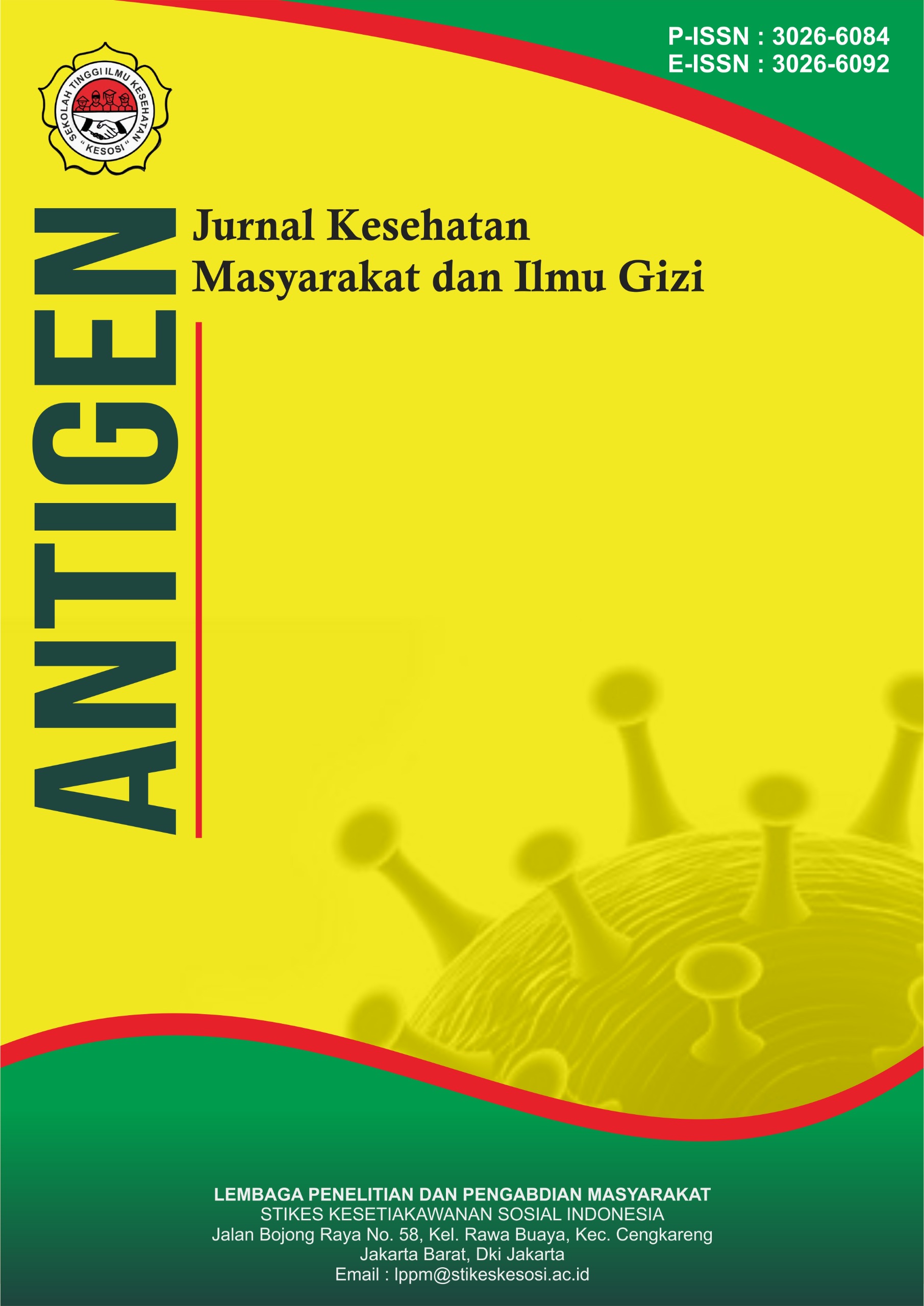Hubungan Penambahan Berat Badan Ibu Selama Hamil dan Kepatuhan Kunjungan Antenatal Care (ANC) dengan Berat Lahir Bayi
DOI:
https://doi.org/10.57213/antigen.v3i2.671Keywords:
Maternal Weight Gain, Antenatal Care, Birth Weight, LBWAbstract
One of the leading factors contributing to neonatal mortality is low birth weight (LBW), which is often associated with maternal conditions such as Chronic Energy Deficiency (CED). Cases of CED remain relatively common in the operational area of Puskesmas Turi. In 2022, East Java reported an LBW prevalence of 3.96%, which is 0.66% higher than the national average. The coverage of antenatal care (ANC) visits shows a declining trend: 100.8% for the first visit (K1), 94% for the fourth visit (K4), and only 83.1% for the sixth visit (K6), indicating irregular adherence to ANC schedules among pregnant women.This study aims to evaluate the relationship between infant birth weight and maternal weight gain during pregnancy, as well as the level of ANC compliance in the Puskesmas Turi area. The study design employed a cross-sectional approach with a multistage random sampling technique involving 84 mothers. Data were collected through direct interviews and documentation from the maternal and child health (KIA) book. Data analysis was conducted using the chi-square test and Fisher exact test. The results revealed a significant association between maternal weight gain and infant birth weight (p = 0.000), as well as between ANC compliance and infant birth weight (p = 0.002). The role of health cadres is crucial in improving ANC adherence and the nutritional status of pregnant women.
References
Acharya, D., Singh, J. K., Kandel, R., Park, J. H., Yoo, S. J., & Lee, K. (2019). Maternal factors and the utilization of maternal care services associated with infant feeding practices among mothers in rural southern Nepal. International Journal of Environmental Research and Public Health, 16(11), 1887.
Agustina, F. R., Sudiarti, T., Fitri, S. A., & Rusydi, R. (2025). Hubungan kunjungan antenatal care (ANC) dengan kejadian bayi berat lahir rendah di Kecamatan Babakan Madang, Kabupaten Bogor. Journal of Educational Innovation and Public Health, 3(1), 81–90.
Astuti, N. W., & Astuti, D. A. (2025). Hubungan kunjungan antenatal care dengan kejadian berat badan lahir rendah: Studi di wilayah kerja Puskesmas Godean II Sleman, DIY. Buletin Ilmu Kebidanan dan Keperawatan, 4(1), 18–24.
Badan Pusat Statistik. (2020). Statistik Indonesia 2021 (S. S. Rahmat, Ed.; Vol. 1101001). Badan Pusat Statistik.
Dinas Kesehatan Kabupaten Lamongan. (2022). Profil Kesehatan Kabupaten Lamongan Tahun 2022. Dinas Kesehatan Kabupaten Lamongan.
Dinas Kesehatan Provinsi Jawa Timur. (2022). Profil Kesehatan Provinsi Jawa Timur Tahun 2022. Dinas Kesehatan Provinsi Jawa Timur.
Ekasari, T., & Natalia, M. S. (2019). Pengaruh pemeriksaan kehamilan secara teratur terhadap kejadian preeklamsi. Jurnal Ilmu Kesehatan, 3(1), 24–28.
Fitri, S. R. (2025). Hubungan riwayat perokok pasif dan peningkatan berat badan saat hamil dengan kejadian berat badan lahir rendah. Pro Health: Jurnal Ilmiah Kesehatan, 7(1), 39–46.
Inpresari, I., & Pertiwi, W. E. (2021). Determinan kejadian berat bayi lahir rendah. Jurnal Kesehatan Reproduksi, 7(3), 141–149.
Kemenkes RI. (2014). Profil Kesehatan Republik Indonesia Tahun 2013. Jakarta: Kementerian Kesehatan RI.
Kementerian Kesehatan Republik Indonesia. (2022). Profil Kesehatan Indonesia 2021. Kementerian Kesehatan RI.
Kementerian Kesehatan Republik Indonesia. (2024). Peraturan Menteri Kesehatan Nomor 6 Tahun 2024 tentang Standar Teknis Pemenuhan Standar Pelayanan Minimal Kesehatan.
Kementerian Kesehatan. (2020). Peraturan Menteri Kesehatan Republik Indonesia Nomor 21 Tahun 2020 tentang Rencana Strategis Kementerian Kesehatan Tahun 2020–2024. Jakarta: Kementerian Kesehatan RI.
Kusuma, F. N., Riana, S., Agustina, T., & Herawati, E. (2024). The relationship between maternal weight gain during pregnancy and compliance with antenatal care and baby’s weight at birth. Eduvest: Journal of Universal Studies, 4(6), 5377–5387.
Nadiya, S., & Fazira, F. (2021). Hubungan pertambahan berat badan ibu dengan berat badan bayi lahir di wilayah kerja Puskesmas Peusangan Kabupaten Bireuen. Journal of Healthcare Technology and Medicine, 7(1), 407–416.
Pitriani, T., Nurvinanda, R., & Lestari, I. P. (2023). Faktor-faktor yang berhubungan dengan meningkatnya kejadian bayi berat lahir rendah (BBLR). Jurnal Penelitian Perawat Profesional, 5(4), 1597–1608.
Prawirohardjo, S. (2014). Ilmu Kebidanan. Jakarta: Bina Pustaka.
Proverawati, A., & Ismawati, C. (2010). Asuhan pada BBLR dan pijat bayi. Yogyakarta: Nuha Medika.
Rizkika, A., Rahfiludin, M. Z., & Asna, A. F. (2023). Low birth weight related factors at Kertek 2 Public Health Centre Wonosobo Regency. Amerta Nutrition, 7(1).
Sutarjo, U. S. (2014). Profil Kesehatan Indonesia Tahun 2014. Jakarta: Kementerian Kesehatan RI.
Widiawati, S. (2017). Hubungan sepsis neonatorum, BBLR dan asfiksia dengan kejadian ikterus pada bayi baru lahir. Riset Informasi Kesehatan, 6(1), 52–57.
World Health Organization. (2022). WHO recommendations for care of the preterm or low birth weight infant. Geneva: World Health Organization.
Downloads
Published
Issue
Section
License
Copyright (c) 2025 Antigen : Jurnal Kesehatan Masyarakat dan Ilmu Gizi

This work is licensed under a Creative Commons Attribution-ShareAlike 4.0 International License.






